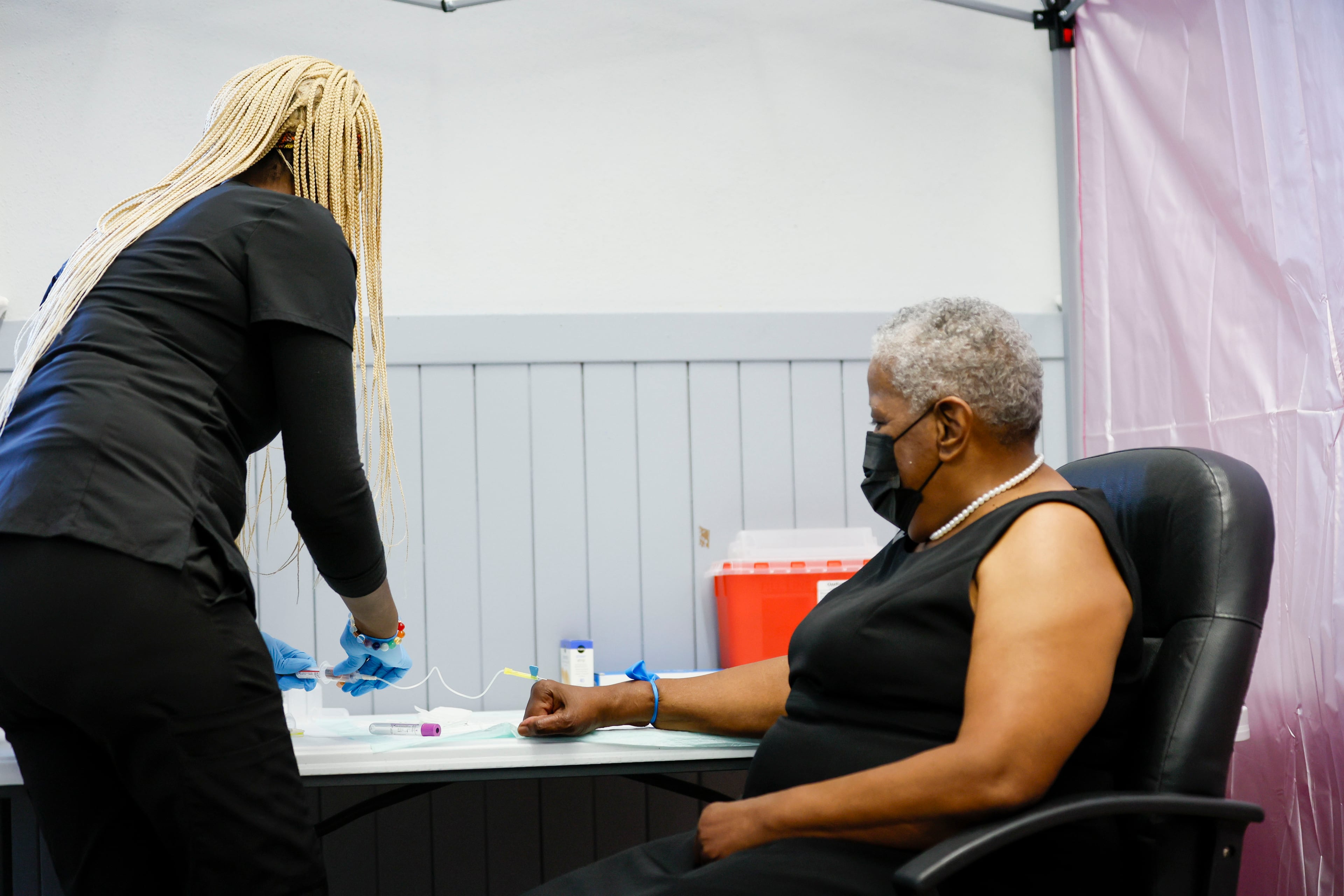Study finds high ‘forever chemical’ levels in some Georgia residents’ blood

If there’s a “ground zero” for Georgia’s “forever chemical” pollution problems, it’s the state’s northwest corner, the heart of the region’s famed textile and flooring industry.
For decades, factories in the area have used the manmade compounds — known by their chemical name per- and polyfluoroalkyl substances, or PFAS, for short — to make products stain- and water-resistant.
But the chemicals do not break down in nature, and their use has contaminated land, rivers and drinking water supplies across the region. The situation has sparked lawsuits, costly upgrades to drinking water plants and worries about the effects on human health.

Now, Emory University researchers have announced the results of a study that found many residents of two northwest Georgia cities — Rome and Calhoun — have higher levels of PFAS coursing through their veins than most of the U.S. population. For some participants, the “forever chemical” concentrations found in their bloodstreams were many orders of magnitude higher than their peers.
The Emory researchers said the area’s history of pollution and the community’s eagerness to participate led them to focus on Rome and Calhoun. Possible health impacts of exposure to “forever chemical” pollution were not part of the study.
Dolly Baker, a cosmetologist and Calhoun resident, received results showing her blood contained total PFAS levels at 1,300 nanograms per milliliter, 260 times the national average determined by the most recent National Health and Nutrition Examination Survey.
Baker said the news was devastating and has left her with more questions than answers.
“I feel lost,” Baker said.
‘Some really high ones’
For about an hour Wednesday night, Emory researchers involved in the study joined participants via videoconference to share the early results and answer questions.
Beyond carpeting, PFAS have been used for decades in products like firefighting foams and food wrappers. The chemicals are now found in water systems across the country — and in the bodies of nearly all Americans.
But in the study group of nearly 180 residents, the Emory team found unusually high levels of exposure.
For five of the seven chemicals that researchers tested for, study participants’ blood concentrations were above the national average, with some displaying levels higher than almost all other U.S. residents.
For PFOA — one of the most widely used “forever chemicals” — more than 40% of participants had blood levels exceeding 95% of the U.S. population. Almost 12% tested above the 95th percentile nationally for PFHxS, a type of PFAS used in water and stain-resistant coatings for carpets, food wrappers and other products, according to the Environmental Protection Agency.
Research has tied exposure to even minuscule concentrations of several PFAS — including PFOA, PFHxs and others the researchers tested for — to serious health conditions. Known health effects include fertility problems and increased risk of certain cancers, along with developmental delays and muted vaccine responses children.
The results of the Emory study have not been peer-reviewed yet, but the researchers said they plan to submit the findings for publication in a scientific journal.
Dana Barr, an Emory environmental health professor and part of the study team, said she was not shocked PFAS were detected in residents’ blood. What was surprising, she said, was the “broad range” of exposure levels they found.
“There were some really low ones and some really high ones,” Barr said.
‘Hints’ about exposure
The researchers tested 177 residents of northwest Georgia: 93 from Rome and 84 from Calhoun.
The study only evaluated exposure; not how the chemicals’ ended up in participants’ bodies, nor whether they’re responsible for any specific health conditions.
But the researchers said the results revealed “hints” about how residents may be exposed.
The survey team’s preliminary findings revealed PFAS levels in participants’ blood increased by an average of 7.7% for every 10 years of residence in Gordon and Floyd counties. Gordon County is home to Calhoun, and Rome is located in Floyd County.
The team also found participants who drank bottled water instead of tap tended to have lower concentrations of three of the PFAS examined in their bodies.
During the web conference, Barr cautioned that more analysis is needed, but said “this does indicate that drinking water source can contribute to the PFAS levels we evaluated.”
The region’s flooring industry has a long legacy of PFAS use. Dalton — the “carpet capital of the world” — sits an hour north of Rome. Calhoun and nearby Chatsworth are also dotted with flooring factories.
It’s been known for years that the PFAS are present in the water used in many of the area’s cities and towns. Past testing by state and local governments have revealed levels in some drinking water supplies exceeding federal standards and guidelines.
Doug Walker, a spokesman for the city of Rome, said the city had not had time to review the data, but pointed out that it has taken steps to address pollution in its water supply.
“This is why Rome has been so proactive in seeking a solution to the problem and is continuing to move forward with the design of a state-of-the-art reverse osmosis water treatment facility,” Walker said.

In 2016, Rome stopped pulling water from one of its two rivers because of high PFAS levels and now uses new treatment technologies to remove more of the chemicals.
The city later sued several chemical and flooring giants, including 3M, DuPont, Shaw Industries, Mohawk Industries and the city of Dalton’s water provider, Dalton Utilities, over the pollution. In 2023, Rome agreed to settle the case and received about $279 million, based on settlement terms obtained by The Atlanta Journal-Constitution. With the money, the city is building a new, $200 million water treatment plant that’ll open in 2029.
Kay Phillips, a spokeswoman for Dalton Utilities, declined to comment on the study. 3M, Mohawk and Shaw, along with Dupont and one of its spinoffs, Corteva Agriscience, did not respond to inquiries about the study findings.
Jess Loizeaux, a spokeswoman for the chemical manufacturer Chemours, which was spun off from DuPont in 2015 and was also a defendant in the Rome case, said the company does not have a manufacturing footprint in Georgia.
Loizeaux added the company has “never intentionally manufactured or used” the chemical PFOA in any manufacturing processes and that sites owned by the company stopped using PFOA before Chemours became independent.
“Furthermore, Chemours has never made, used or sold PFOS,” Loizeaux added. PFOS is another “forever chemical” the Emory researchers tested for.
An attorney for the city of Calhoun did not offer comments on the research.
Seeking answers
The Emory researchers say they hope to expand the study to include more participants and answer questions about how residents have been exposed — and whether their health is suffering as a result.
They also want to try to include children in future rounds of testing. The effects of PFAS in children is an area of active research, but the EPA says studies have shown they may be more sensitive to the chemicals’ effects because they’re still developing.
Whether they’ll be able to secure the funding needed to expand is another question.
The pilot study was supported by a $30,000 grant from the National Institutes of Health, the federal government’s medical research arm. But President Donald Trump’s administration has terminated thousands of research grants and has proposed cutting $18 billion from the agency’s nearly $48 billion budget next year.
Barr said that could increase competition for future funding, but made the case that the research they want to conduct falls “within the purview, the interests and the agenda of this current administration.”
Study participants, in the meantime, are trying to figure out their next steps.
Calhoun resident Paul Shoffner said his tests revealed total blood PFAS levels of 33 nanograms per milliliter, more than double the 95th percentile value nationally.
Shoffner suffers from hypertension – a condition some studies have connected to PFAS exposure, though mostly in pregnant women. He said he has no family history with the disease and wonders if the chemicals are to blame. Shoffner said he’s grateful to Emory for conducting the study, but is searching for what to do next.
“All we want are some answers,” Shoffner said.



